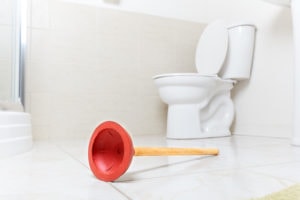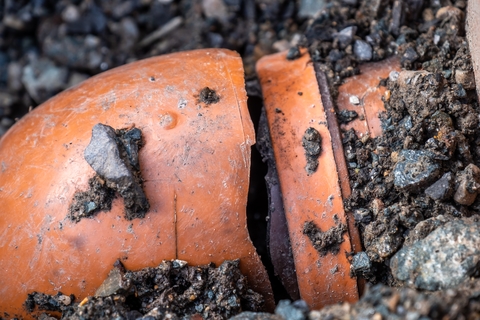How To Spot A Sewer Line Problem (And What to Do About It)

How to Spot a Sewer Line Problem (And What to Do About It)
Are clogs and backups affecting every plumbing fixture in your home? Have you been calling the plumber a few times a year for the same problem?
If so, you likely have a sewer line problem. And, it may cost you a lot more than you expected to solve it — upfront, at least.
Your sewer line is the piping that carries all the liquid and solid waste from your home to a septic tank or other disposal site.
Since it’s outside and underground, you never see it — which means problems can grow over time without you noticing.
So, if you’re noticing recurring plumbing problems, or if your plumber just dropped a bombshell — you need to replace your outdoor line — on you, here’s some information to help you sort through everything.
In this article, we’ll go over:
- Spotting a Sewer Line Problem
- Three Common Causes of Sewer Line Clogs
- Old Vs. New Materials for Pipes
- Replacing a Line Vs. Repairing It
Meanwhile, if you have any questions, need a second opinion, or suspect a problem like this in your South Jersey home, call Broadley’s today.
Spotting a Sewer Line Problem
So, how can you tell if you have a sewer line problem or just a clog or backup in the house?
The first significant indicator is if the problem affects the entire house. Are you flushing a toilet upstairs and noticing a sink, shower, or toilet on the first floor gurgle?
If that’s the case, the problem seems to be occurring where all the water leaves the house. In this situation, it’s then backing up into your home.
Compare that to, say, a simple toilet clog where only that one fixture has a problem. Or, a drain line clog that only affects one floor in the house.
When it’s the whole house, your plumber needs to check outside. Since the pipe is underground, they’ll use a camera system to see inside.
You can double-check what they say by asking them to show you the blockage they found. It’s easy to see on the camera monitor.
Three Common Causes of Sewer Line Clogs
Generally, sewer line clogs are often caused by:
- Tree Roots
- Rust Flakes
- Wipes and Paper Towels
It’s worth noting that the first two pertain mostly to older cast iron or galvanized steel pipes. We’ll talk a little more about them in a moment.
Tree Roots
Roots are amazingly pervasive, and it only takes the smallest opening in an underground pipe for them to make their way in.
Once that happens, they grow thanks to the water in there. Then, it’s not long before they become a major obstruction.
An older pipe may form small holes from rust or degradation. In other cases, the joints aren’t completely sealed. They’ve come loose, or the bonding that holds them together broke down over time.
Rust Flakes
Over time, steel, like any metal, rusts. So, you end up with large rust flakes on the inside of a galvanized pipe. They can trap debris as it flows by.
Over time, waste and toilet paper — even the kind designed to disintegrate — will coalesce and harden into a blockage.
Wipes and Paper Towels
Toilet paper is so-called for a reason: It’s made to break down quickly and easily as it passes through your plumbing system. You can’t say the same for paper towels and baby wipes.
If you flush those, they can stay in your pipes forever. Or, at least until you pay someone to clear it out.
Flushing items not designed for flushing isn’t anything new. But, in the early part of 2020, it became much more widespread.
That’s when you had more people staying home all day. And, those who ran out of toilet paper began improvising.
So, even well after that time, we’ll see this continue as a problem since those materials won’t go anywhere without a little help.
Old Steel and Iron Vs. Newer PVC or ABS Piping
Homes built more than 20 years ago often used galvanized steel for their piping. Newer homes use PVC or ABS, both synthetic plastics. For homeowners, knowing which you have can clue you into a potential problem.
The newer materials hold up much better than steel or metal. Those first two problems we mentioned — rust flakes and loose joints — don’t exist with the plastic models.
Of course, flushing non-flushable items is a problem with any material.
At any rate, however, this is worth considering if you’re noticing sewer backups more often: Older pipes may be a big part of the problem.
Sewer Line Replacement Vs. Repairs or Clearing the Line
It seems counter-intuitive, but it’s often true: You’re better off getting the entire sewer line replaced rather than having us unclog it again.
Yes, it’s more expensive — but only in the short term.
If you’ve called more than twice in a year because of a clog like this, then you’re only going to end up calling more and more often. There’s a systemic problem, and it’s only going to get worse.
That means more clogs more often, and pretty soon, you’re paying more over time than you would once to solve the problem once and for all.
Meanwhile, the longer you ignore a problem, the worse it will get. A leak or break means an emergency: You’re without water and suddenly facing a considerable expense.
Yes, it’s frustrating to call a plumber, thinking you’ll pay a few hundred to clear the line only to find out you need to spend more than a thousand dollars. That’s especially so with a problem you can’t see yourself.
That’s why it’s essential to work with a reliable, trusted company. Broadley’s has served Cape May and Atlantic counties for nearly a century, and you don’t earn that kind of longevity without a track record of honest, outstanding work.
And, with that track record comes the experience that makes a job faster and easier. We know the terrain, literally: What to expect under the ground in different towns and neighborhoods, and being prepared for it at the beginning of the job.
If you suspect a problem with your sewer lines, don’t wait until there’s an emergency. Call Broadley’s for an inspection and find out the best way to solve the problem.






